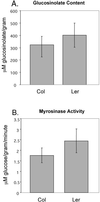The TASTY locus on chromosome 1 of Arabidopsis affects feeding of the insect herbivore Trichoplusia ni
- PMID: 11402216
- PMCID: PMC111178
- DOI: 10.1104/pp.126.2.890
The TASTY locus on chromosome 1 of Arabidopsis affects feeding of the insect herbivore Trichoplusia ni
Abstract
The generalist insect herbivore Trichoplusia ni (cabbage looper) readily consumes Arabidopsis and can complete its entire life cycle on this plant. Natural isolates (ecotypes) of Arabidopsis are not equally susceptible to T. ni feeding. While some are hardly touched by T. ni, others are eaten completely to the ground. Comparison of two commonly studied Arabidopsis ecotypes in choice experiments showed that Columbia is considerably more resistant than Landsberg erecta. In no-choice experiments, where larvae were confined on one or the other ecotype, weight gain was more rapid on Landsberg erecta than on Columbia. Genetic mapping of this difference in insect susceptibility using recombinant inbred lines resulted in the discovery of the TASTY locus near 85 cM on chromosome 1 of Arabidopsis. The resistant allele of this locus is in the Columbia ecotype, and an F(1) hybrid has a sensitive phenotype that is similar to that of Landsberg erecta. The TASTY locus is distinct from known genetic differences between Columbia and Landsberg erecta that affect glucosinolate content, trichome density, disease resistance, and flowering time.
Figures




References
-
- Agrawal AA. Specificity of induced resistance in wild radish: causes and consequences for two specialist and two generalist herbivores. Oikos. 2000;89:493–500.
-
- Alonso-Blanco C, Koornneef M. Naturally occurring variation in Arabidopsis: an underexploited resource for plant genetics. Trends Plant Sci. 2000;5:22–29. - PubMed
-
- Arabidopsis Genome Initiative. Analysis of the genome sequence of the flowering plant Arabidopsis thaliana. Nature. 2000;108:796–815. - PubMed
-
- Bernays EA, Chapman RF. Host-Plant Selection by Phytophagous Insects. New York: Chapman and Hill; 1994.
-
- Bones AM, Rossiter JM. The myrosinase-glucosinolate system, its organisation and biochemistry. Physiol Plant. 1996;97:194–208.
Publication types
MeSH terms
Grants and funding
LinkOut - more resources
Full Text Sources
Molecular Biology Databases

